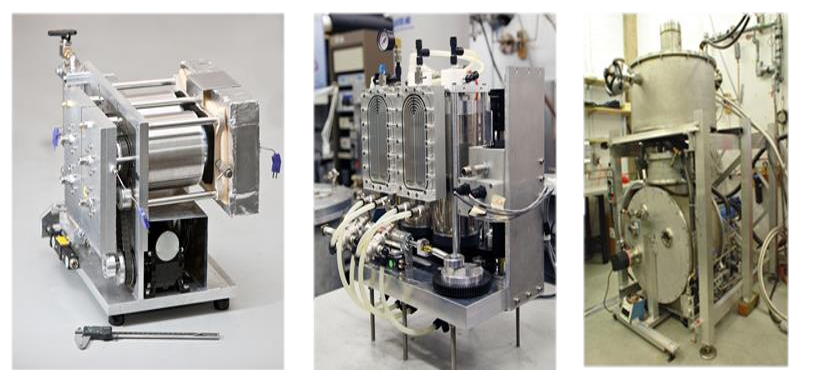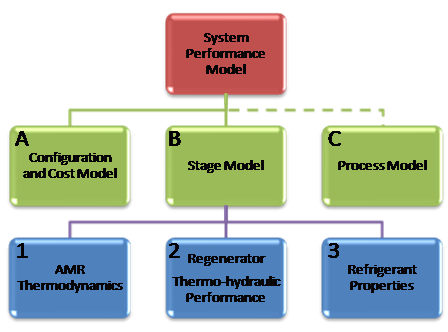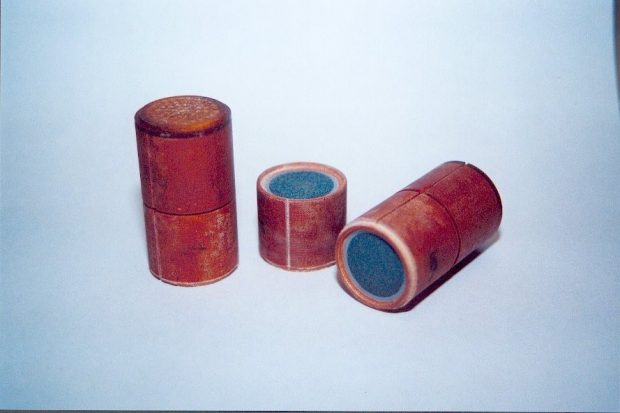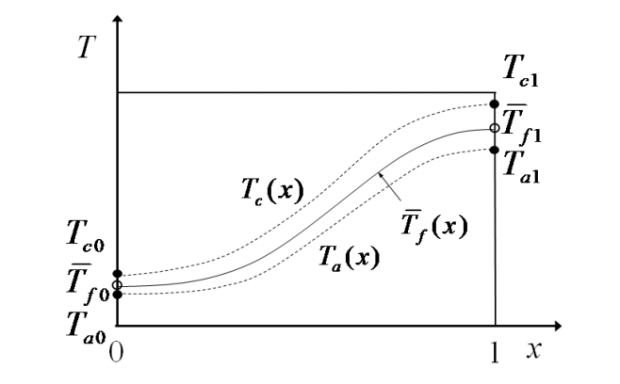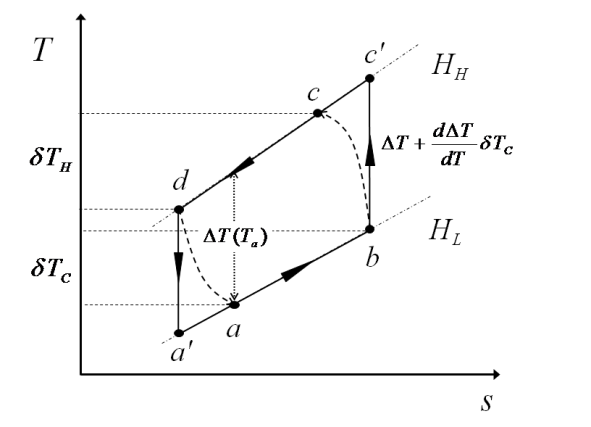Contents
- Introduction. 3
- Magnetic Cycles 3
- Objectives 4
- Activities 5
- Methodology. 5
- Stage Model 6
- Refrigerant Properties 6
- Cost and Configuration. 7
- AMR Experimental Analysis 7
- System Modeling. 8
- References 9
- Appendices 11
- Backgrounder 1: The magnetocaloric effect (MCE). 11
- Backgrounder 2: The active magnetic regenerator (AMR). 11
- Backgrounder 3: A magnetic heat-pump. 11
- Backgrounder 4: Permanent Magnet AMR Device Configuration. 11
1. Introduction
Heating, refrigeration, and air-conditioning account for ~40% of annual primary energy supply and demands for these services are expected to grow world-wide. Assuming future increases in the costs for electricity, and without significant improvements in performance, absolute energy consumption, related emissions, and cost of these services will increase. Given the limited potential for improvements with current devices, there is a need to determine what other technologies may have the ability to provide cost-effective, safe, and efficient service. Devices using magnetic cycles have been proposed as technologies with the potential for higher efficiencies than current vapour-compression systems. These devices use a property known as the magnetocaloric effect and devices based on an active magnetic regenerator (AMR) cycle are the most viable to date.
While there is data showing high efficiency with an AMR cycle, there is still no commercially competitive magnetocaloric technology at room temperature. Recently, researchers around the world have developed numerous test-beds and prototypes using a range of magnetocaloric materials [1]. On an individual basis, the work is often limited to specific materials, operating conditions, applied field strengths and configurations. As of yet, there is no preferred device configuration. For these reasons, and others, determining the potential of magnetic devices is difficult.
The UVic research team has built three different devices to study active magnetic regeneration cycles covering the cryogenic to room-temperature range: i.e. hydrogen liquefaction as well as near room-temperature heat pumping. These devices are used to determine the impacts of materials and operating conditions, and to measure key parameters like temperature span, cooling power, and efficiency. Modeling is also an area of focus for both materials and cycle analysis. A number of different modeling approaches are being developed to balance detail with speed.
The research activities described here are aimed at understanding and quantifying theoretical and practically achievable performance of magnetic heat pumps and refrigerators. The metrics used to determine the potential of a magnetic device are efficiency and total cost of service. Theoretical idealized cases are used to determine the best-case performance and cost. Known materials with real losses are analyzed to determine practical values. Based on these results, and the potential for improvement, areas of application are determined.
2. Magnetic Cycles
Heating and cooling services are often provided by end-use energy conversion technologies where small gains in efficiency can result in significantly less primary energy consumption. A range of mature technology options are currently available where the total cost of ownership is dominated by equipment cost in the case of high efficiencies, or by operating costs where inefficient technologies are used. Improvements in the efficiency of conventional systems are possible, but, because of a long history of optimization, it is becoming more difficult to increase performance without significantly impacting cost [2].
Solid materials displaying reversible temperature changes due to magnetic field variations have been suggested as the working media for more efficient refrigeration and heat pump cycles [1]. Materials possessing this so-called magnetocaloric effect (MCM) range from single elements to multi-material alloys (See Backgrounder 1.) Near the magnetic ordering temperature, the reversible temperature change due to the magnetocaloric effect can be significant; however, properties can vary significantly as can cost [3, 4].
When implemented as a regenerator the magnetic solid is used as a thermal storage medium as well as the means of converting magnetic work to net heat transfer. This is known as an active magnetic regenerator (AMR) (See Backgrounder 2.) A heat transfer fluid oscillates through the AMR while the material is cycled through a low and high magnetic field. The net effect is transfer of heat from a cold heat exchanger to a hot heat exchanger. Regenerators have some of the highest surface areas per unit volume so they are effective and compact heat transfer structures.
Magnetic devices have been shown to have the potential for high cycle efficiencies and power densities [5]. Because the magnetization process can be highly reversible, magnetic work input is efficient. Perhaps more importantly, the work associated with demagnetization is inherently recovered. In a magnetic device, the heat transfer fluid flows through the AMRs, transferring energy between the hot and cold heat exchangers on either end (See Backgrounder 3.) While progress continues to be made, magnetic devices have yet to demonstrate performance comparable to fluid-compression system in all aspects needed for commercial deployment.
To date, various amounts of research have been reported in the literature. Synthesizing and characterizing the basic properties of magnetocaloric materials has received the most attention [6]. Modeling of AMRs and devices is an area with increasing activity [7]. The testing of active magnetic regenerators using single and multiple magnetocaloric materials is an important area [8, 9]. The design, construction and testing of prototype devices is becoming more common, but there are many proposed designs configurations (See Backgrounder 4.)
Further research quantifying the impacts of materials, operating parameters, and device configuration on performance is needed to determine the commercial potential of magnetic devices.
3. Objectives
The goal of this work is to increase our understanding of magnetic cycles, the theoretical principles of systems, and to determine the potential of magnetic devices in terms of performance and cost. The scope of work is restricted to devices using active magnetic cycles.
Characterizing potential requires answers to the following questions:
- What are the minimum material properties needed for a magnetic device to meet specified operating conditions? How much material is required?
- Which known materials have the potential to meet performance requirements? Are they cost effective? How much hysteresis can be allowed?
- What is the impact of practical regenerator thermal and hydraulic properties on performance?
- What device design characteristics are needed for a given application?
- What is the efficiency?
- What is the expected lifetime of a magnetic device?
- What is the total cost of ownership?
A short term objective is to create and validate a modeling tool to provide answers to the above questions. Doing so will identify preferred materials and regenerator designs, what the cost characteristics of magnetic devices are, how broadly magnetic devices might be used (i.e. what scales and operating characteristics), and where research and development priorities should be directed.
4. Activities
The proposed modeling platform includes sub-models for device performance, the AMR cycle, regenerator effectiveness, matrix properties, and cost calculations. A discussion of methodology, tasks, and linkages follows.
a. Methodology
The general approach to creating a system modeling tool is shown in Figure 1. The main sub-task is developing a stage model (B) which comprises a thermodynamic description of the AMR cycle (B1), a collection of sub-routines to define regenerator properties (B2), and, a module which provides magnetocaloric properties of the regenerator matrix (B3). The stage model is linked to a system configuration to simulate device performance (A). This information then drives a cost calculation module (A). For complex processes, such as liquefaction or cascaded systems, a process module would use multiple device models in parallel or series (C.) (This component is future work and will not be discussed further.)
Figure 1. Tasks and relationships to create a performance model of a magnetic system.
A reliable system tool must have a validated performance model. With prototype devices using both permanent magnets and superconducting magnets available at the University of Victoria, experimental data will be generated for validation. In the following sections, the main research activities will be described in more detail followed by a brief description of the experimental devices used to generate test data.
b. Stage Model
Determining the performance of magnetic devices requires a sound understanding of the thermodynamic cycle employed and the desired operating conditions. The main component of the system model is the stage model which focuses on the performance of a single active magnetic regenerator. Modeling AMR performance is an active area of research, but most methods require relatively detailed models of the regenerator and the matrix. As a result, simulations can be complex and may only be accurate over a limited range of parameters. For computational efficiency, a simplified modeling approach is used to capture the key physical interactions occurring in an AMR cycle with less resolution on dynamics. The governing expressions come from a thermodynamic approach to cycle analysis. Expressions describing the enthalpy flux through the regenerator, the local magnetic work, and the temperature distributions at select points in the cycle have been derived and reported elsewhere [10, 11]. Detailed dynamic modeling of AMRs is also used where higher resolution or more specific probing is desired.
This work includes programming the numerical routines and validating them against experimental data. Variables of interest include regenerator dimensions, matrix structure, field strength, fluid properties and operating waveforms for fluid flow and field change. Based on this information, regenerator heat transfer effectiveness, internal losses, and pressure drop can be determined using a thermo-hydraulic sub-model (Item B2 in Figure 1.) Performance metrics are determined from model outputs such as losses, output power and efficiency.
Validation of the stage model is performed using information from the literature as well as experimental data produced in the laboratory. With a validated numerical model, sensitivities to operating parameters can be determined and device requirements specified.
c. Refrigerant Properties
The magnetocaloric properties of the regenerator matrix are central to determining AMR performance. Properties such as magnetic entropy change, specific heat, and adiabatic temperature change as a function of magnetic field and temperature are needed. Some materials can be easily modeled using simple theoretical approaches while other materials show more complex ordering and are not easily simulated. The thermodynamic modeling approach described above can use real or arbitrary material properties.
To determine an upper performance range for any AMR-based magnetic device, idealized magnetocaloric and regenerator properties are assumed [12]. From this baseline, the impacts of real properties can then be compared. Where possible, measured data is used to create functions for specific heat and adiabatic temperature change. Second-order materials can also be modeled effectively using mean field theory (MFT) and code for calculating magnetization as function of temperature and field has already been created at UVic [13, 14]. First order materials can be more difficult to model. One way to deal with this is to combine experimental data with scaling curves to synthesize a broader array of materials representing any chosen Curie temperature.
One are of work is the creation of a modeling approach that synthesizes properties for multiphase composite materials. It has been shown that mixtures of solid refrigerants (composites) can produce broad ordering curves [15]. This is another way to approximate an ideal material (besides layering materials.) To date, the work reported in the literature has focused only on thermodynamic properties (ie. steady-state characterization of specific heat and entropy.) An important issue that may arise with composites is the effect of finite heat transfer rates between constituents in a composite mixture. This can be analyzed with a lumped dynamic model. This is important as it is expected that commercial devices will operate with cycle times on the order of 1 Hz or more. If thermal contact between particles is poor, then the internal heat transfer irreversibility could easily negate the benefit of a composite.
A final aspect of the refrigerant modeling task is to understand the effects of hysteresis. Some magnetocaloric materials show hysteresis behavior in their magnetic response which gives rise to an irreversibility. Because the current simplified thermodynamic model does not require detailed knowledge about specific temporal relationships in a cycle (a cycle-averaged approach is used,) hysteresis can be included with relative ease. The simplified approach includes a generic source term in the energy balance equations which can be used to simulate hysteresis. Over a complete cycle, hysteresis manifests as additional magnetic work which is locally dissipated as heat in the regenerator. An open question with regards to hysteresis is the impact on the actual adiabatic temperature change and is an area of focus.
d. Cost and Configuration
The magnet and magnetocaloric material are the two main items which differentiate magnetic devices from compressor driven cycles. The volumes required depend upon the device design and there are many possible configurations that a magnetic device may take. A method of categorizing AMR device configurations and how this relates to cost is described in Refs [16, 17]. A configuration descriptor, D, quantifies the relative amount of magnetocaloric material and magnet material used in a particular design. A magnet performance parameter, , provides a measure of how efficiently permanent magnet material is used to generate a useable high field region. In combination with the specific exergetic cooling power, μ, (the useful cooling power normalized by field and volume of material) and efficiency, the cost structure of a device is prescribed. The total device cost is then largely determined by the specific costs of working material and permanent magnet material. If the specific exergetic power is sufficiently high, a refrigeration device with more expensive components can provide cooling power at a lower cost than other magnetic devices with a lower cost structure.
Geometric data on magnetic devices is needed to create a range of configurations for analysis. In addition, magnet designs can be analyzed to generate an expected range of magnet performance parameters. Cost data for magnetocaloric and permanent magnet material are collected from commercial sources. Another consideration affecting cost of service is the expected lifetime of materials. This is less well-known and so a sensitivity analysis is performed to examine material limitations due to aging and cycling. Total costs are determined for various cases of discount rate, capital recovery time, electricity costs, and annual capacity factor.
e. AMR Experimental Analysis
A robust performance model with predictive capability must be thoroughly validated against reference information. This may come from other models, but, preferably, experimental data should be used. This is an important area of activity at UVic and a number of devices have been developed in the lab (Figure 2.) [18, 19] Besides providing test information on specific material compositions and shapes, data is generated for wide array of operating conditions, types of fluid, field strengths, and fluid capacity rates (utilizations.)
A range of materials from the MnFe(P,X) family with first-order behavior are currently of interest. These materials have tunable transition temperatures near room temperature and relatively low hysteresis. Other MCM materials are also available for testing at UVic. Combined, these materials provide data for first and second order materials thereby giving the stage model a broad array of conditions to validate against. Testing includes single material and multi-material regenerators. Preferred conditions to maximize temperature span and cooling power are determined experimentally and compared to optimized parameters found using numerical simulation. Valuable information on the AMR cycle can be obtained due to the ability to measure temperature distributions through the regenerators.

Figure 2. AMR based magnetic devices available at UVic. Two devices use permanent magnets while a third utilizes a superconducting magnet. A range of fluids, frequencies, and field strengths are possible.
f. System Modeling
The final component of research is the creation of a system modeling tool and using it to analyze the performance of magnetic heat-pumps and refrigerators. This work integrates the sub-models described above. Once integrated and de-bugged, a system model can be coupled to an optimization routine to determine what conditions maximize efficiency and performance or minimize cost. Finally, various scenarios can be analyzed which represent requirements and applications currently in the market. The main parameters varied are cooling power (or heating power) and temperature span. Standard operating points are used so as to provide data for comparison to conventional systems.
5. References
[1] KA Gschneidner Jr., VK Pecharsky, AO Tsokol. Recent developments in magnetocaloric materials, Reports of Progress in Physics. 68 (2005) 1479-1539.
[2] T Catania. Standards and Codes: Appliances & the Smart Grid, ASHRAE Journal. 54 (2012) 72-77.
[3] E Brück, O Tegus, XW Li, FR de Boer, KHJ Buschow. Magnetic refrigeration—towards room-temperature applications, Physica B: Condensed Matter,. 327 (2003) 431-437.
[4] KA Gschneidner Jr., VK Pecharsky. Thirty years of near room temperature magnetic cooling: Where we are today and future prospects, International Journal of Refrigeration,. 31 (2008) 945-961.
[5] KL Engelbrecht, GF Nellis, SA Klein, AM Boeder, Modeling active magnetic regenerative refrigeration systems, (2006) 265-74.
[6] VK Pecharsky, KA Gschneidner Jr. Magnetocaloric effect and magnetic refrigeration, Journal of Magnetism and Magnetic Materials, 200 (1999) 44-56.
[7] KK Nielsen, J Tusek, K Engelbrecht, S Schopfer, A Kitanovski, CRH Bahl, et al. Review on numerical modeling of active magnetic regenerators for room temperature applications, Int.J.Refrig. 34 (2011) 603-616.
[8] K Engelbrecht, CRH Bahl, KK Nielsen. Experimental results for a magnetic refrigerator using three different types of magnetocaloric material regenerators, Int.J.Refrig. 34 (2011) 1132-1140.
[9] A Rowe, A Tura. Experimental investigation of a three-material layered active magnetic regenerator, International Journal of Refrigeration,. 29 (2006) 1286-1293.
[10] A Rowe. Thermodynamics of active magnetic regenerators: Part I, Cryogenics. 52 (2012) 111-118.
[11] A Rowe. Thermodynamics of active magnetic regenerators: Part II, Cryogenics. 52 (2012) 119-128.
[12] AM Rowe, JA Barclay. Ideal magnetocaloric effect for active magnetic regenerators, J.Appl.Phys. 93 (2003) 1672-1676.
[13] O Peksoy, A Rowe. Demagnetizing effects in active magnetic regenerators, Journal of Magnetism and Magnetic Materials. 288 (2005) 424-432.
[14] A Rowe, A Tura. Active magnetic regenerator performance enhancement using passive magnetic materials, J Magn Magn Mater. 320 (2008) 1357-1363.
[15] R Caballero-Flores, V Franco, A Conde, KE Knipling, MA Willard. Optimization of the refrigerant capacity in multiphase magnetocaloric materials, Appl.Phys.Lett. 98 (2011) 102505.
[16] A Rowe, Performance Metrics for Active Magnetic Refrigerators, (2009) 195-205.
[17] A Rowe. Configuration and performance analysis of magnetic refrigerators, Int.J.Refrig. 34 (2011) 168-177.
[18] A Tura, A Rowe. Permanent magnet magnetic refrigerator design and experimental characterization, Int.J.Refrig. 34 (2011) 628-639.
[19] A Tura, J Roszmann, J Dikeos, A Rowe. Cryogenic active magnetic regenerator test apparatus, Advances in Cryogenic Engineering, Vols 51A and B. 823 (2006) 985-992.
6. Appendices
a. Backgrounder 1: The magnetocaloric effect (MCE).
b. Backgrounder 2: The active magnetic regenerator (AMR).
c. Backgrounder 3: A magnetic heat-pump.
d. Backgrounder 4: Permanent Magnet AMR Device Configuration
| Backgrounder 1: The magnetocaloric effect (MCE). | |
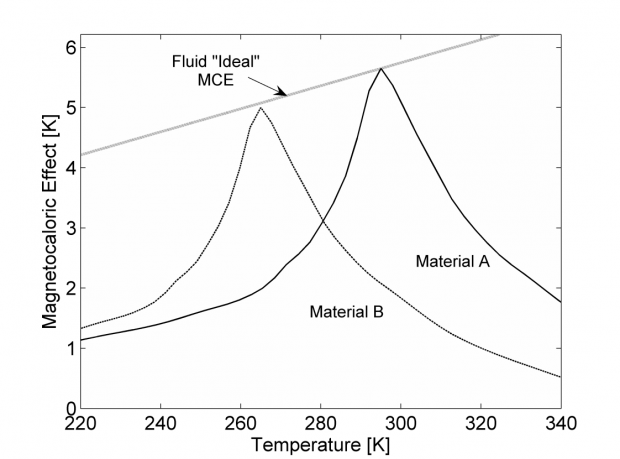 |
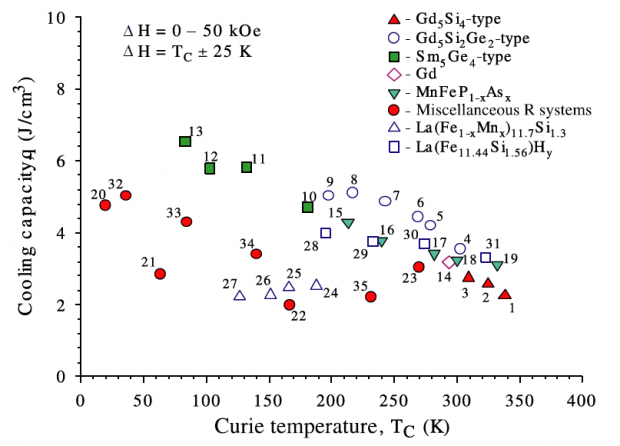 |
|
Numerous materials exhibit the magnetocaloric effect (MCE) – a reversible temperature change which can be measured when a thermally isolated material is subjected to a change in applied magnetic field. These materials have a change in entropy due to magnetic ordering which is significant relative to the entropy of the lattice. Although low temperature applications were first explored, work in the mid 1970’s at Los Alamos National Laboratory showed that near a magnetic phase transition, the magnetocaloric effect could be large even near room temperature, although the effect decreases quickly as temperature deviates from the ordering temperature (also known as the Curie temperature.) Because of the narrow response, more than one material is used in AMRs so that a device can operate over a broader temperature span. The standard method of comparing materials is to calculate their relative cooling capacity (RCP) which simply combines the magnitude of the magnetic entropy change and the temperature span over which this ordering is 50% of the peak value or higher [4]. Most of the better materials have an RCP of ~ 2-5 J/cm3. Often, this parameter is reported in J/g, but this is less meaningful as cost scales with volume so J/cm3 is more appropriate. Experimental data from actual AMR devices indicates that RCP is an incomplete metric for ranking materials as some materials with high RCP may not generate better performance than a lower RCP material. |
|
| Backgrounder 3: A magnetic heat-pump. |
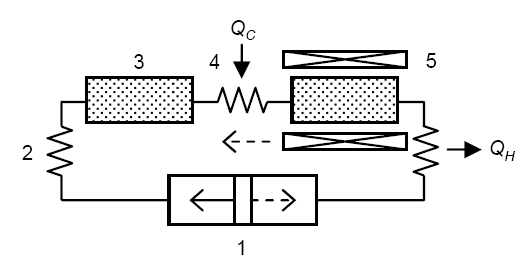 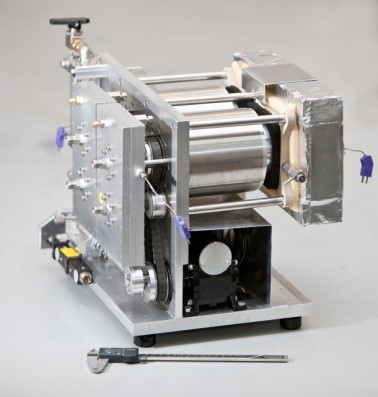 |
|
A magnetic heat-pump, or refrigerator, can be created with at least two active magnetic regenerators operating together, but out of phase. The two regenerators modulate the temperature of the heat transfer fluid oscillating through both AMRs and linked by a cold heat exchanger. Oscillating fluid flow may be created with a displacer or, a pump and rotary valves. Water-glycol mixtures are often used as the heat transfer fluid, but this is not a requirement. The magnetization of a regenerator may be created by moving the regenerator bed in and out of a magnetic field, by moving the magnets with respect to stationary regenerator beds, or by moving magnet arrays so that the local field oscillates in strength. Different approaches present different advantages and disadvantages. Stationary AMRs can be easier to seal, but moving magnets may only be possible if the frequency is low. Moving AMRs usually requires dynamic seals which presents a challenge to controlling the fluid flow.
|
| Backgrounder 4: Permanent Magnet AMR Device Configuration. | ||
 |
 |
 |
| D1 | D2 | D3 |
| There are many different configurations that can be realized for an AMR-based magnetic device. More than one magnet might be used and many regenerators are possible; however, all devices can be categorized according to a configuration parameter (D) that takes into account the total volume of all high field regions and the total volume of magnetocaloric material. In an ideal device, the value of the configuration parameter, D, indicates the ratio between the total volume of all regenerators, and the total volume of all high field regions. The type of magnet array and shape leads to another configuration parameter describing magnet performance. With the configuration and magnet parameters defined, and knowing the cooling power or net heat transfer and the efficiency, the cost of providing service with a magnetic device can be determined. | ||
